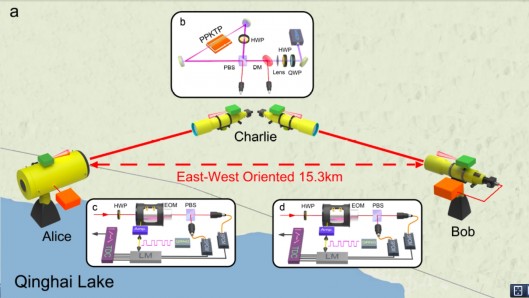Quantum "spooky action at a distance" travels at least 10,000 times faster than light
By Brian Dodson
March 10, 2013

The speed of entanglement dynamics is at least 10,000 times faster than light according to Prof. Juan Yin and colleagues ( Photo: Shutterstock)
Quantum entanglement, one of the odder aspects of quantum theory, links the properties of particles even when they are separated by large distances. When a property of one of a pair of entangled particles is measured, the other "immediately" settles down into a state compatible with that measurement. So how fast is "immediately"? According to research by Prof. Juan Yin and colleagues at the University of Science and Technology of China in Shanghai, the lower limit to the speed associated with entanglement dynamics – or "spooky action at a distance" – is at least 10,000 times faster than light.
Despite playing a vital role in the development of quantum theory, Einstein felt philosophically at odds with its description of how the universe works. His famous quote that "God does not play dice" hints at his level of discomfort with the role of probability in quantum theory. He believed there exists another level of reality in which all of physics would be deterministic, and that quantum mechanics would turn out to be a description that emerges from the workings of that level – rather like a traffic jam emerges from the independent motions of a large number of cars.
Niels Bohr and Albert Einstein debating quantum theory in the mid 1920s
In 1935 Einstein and his coworkers discovered quantum entanglement lurking in the equations of quantum mechanics, and realized its utter strangeness. This lead to the EPR paradox introduced by Einstein, Poldolsky and Rosen. The EPR paradox stated that the only ways of explaining the effects of quantum entanglement were to assume the universe is nonlocal, or that the true basis of physics is hidden (otherwise known as a hidden-variable theory). Nonlocality in this case means that events occurring to entangled objects are linked even when the events cannot communicate through spacetime, spacetime having the speed of light as a limiting velocity. Nonlocality is also known as spooky action at a distance (Einstein's phrase).
Einstein, as the primary prophet of relativity theory, was revolted by the notion of nonlocality, and hence regarded the EPR result as a demonstration that underlying quantum mechanics was a deterministic hidden-variable theory. On this occasion, however, Einstein was wrong.
John Bell, in the early 1960s, demonstrated that correlations between the properties of particles in any local theory (not just quantum mechanics) were weaker than the correlations predicted by quantum mechanics. In other words, quantum mechanics is intrinsically nonlocal. Bell's Inequality can be and has been thoroughly tested experimentally, and although a tiny loophole or two are still outstanding, these experiments show that the quantum world is indeed nonlocal.
So is the spooky action at a distance associated with entanglement actually instantaneous, or does it simply has a very large propagation speed? This seems a fair question to ask, and it's the challenge that was taken up by Prof. Yin's group. In their experiment, Alice and Bob (stars of many quantum adventures) were sent to two locations separated by 15.3 km (9.6 miles). Charlie, located equal distances from Alice and Bob, generated a pair of entangled photons, then sent one to Alice and one to Bob. The difference in the distance the photons traveled between Charlie and Alice and between Charlie and Bob was less than about 10 cm (4 in). All three of our participants have synchronized, highly accurate clocks. Charlie generates a pair of entangled photons, and records the time.
Both Alice and Bob have a mechanism for measuring the polarization of the incoming photons, but both mechanisms have randomly rotating polarization filters, so over time all polarization directions are measured, and at no time is there a correlation between Alice and Bob's polarization directions. When Alice detects a photon, she records the polarization and the time at which the measurement was made. When Bob measures his photon, he also records the polarization and the time of arrival.
Space-time diagram of Prof. Yin's experiment. The entangled photons were generated at E, but the decisions about which measurements to make are not located within E's future light cone, meaning that those decisions cannot be affected by the generation process
Later the three get together to compare notes. Alice's and Bob's measurements were made at the same time, to within about 0.35 nanoseconds, and the decision on which way the polarization direction of their devices would point was decided about 3 microseconds before the photons arrived at the detectors. If Alice and Bob always measured the same polarization direction, the entanglement influence traveled 15.3 km in less than the possible difference in the measurement times they recorded (0.35 ns). If, on the other hand, the entanglement influence traveled more slowly, Alice and Bob would measure randomly different polarization directions.
Prof Yin's experiment, which was a bit more complicated in detail than the above simplification, observed no difference in polarization direction. The time it would take light to travel between Alice and Bob was about 50 μs, while the action of the entanglement dynamics had to be less than 0.35 ns. The minimum speed of the entanglement influence is just the one divided by the other, or 144,500 times the speed of light. However, a number of factors go into the interpretation of the results, which reduce the lower limit of the speed of entanglement influence to about 10,000 times the speed of light.
Notice that this result does not eliminate the possibility that the influence of entanglement actually is instantaneous – it merely sets a limit saying how close the influence must be to infinitely fast. Another possibility that is gaining credence is that entanglement dynamics may operate external to time, or at least may ignore time as it ignores distance.
Niels Bohr, one of the prime developers of quantum theory, once said that those who are not shocked when they first encounter quantum theory cannot possibly have understood it. Eighty years later, this is still true, and applies even to those of us who first encountered quantum theory decades ago. It has been refined into an amazing tool, but we are woefully lacking in the ability to say how the world can work this way. Hope springs eternal.
Source: Bounding the speed of `spooky action at a distance' – arXiv.org (PDF)
Copyright © gizmag 2003 - 2013 To subscribe or visit go to: http://www.gizmag.com


